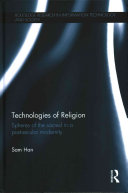
Technologies of Religion PDF
142 Pages·2016·2.4262 MB·other
Most books are stored in the elastic cloud where traffic is expensive. For this reason, we have a limit on daily download.
Preview Technologies of Religion
Description:
Breaking new ground by bringing together empirical work done in the vein of the emergent field of "digital religion" and larger social-theoretical discussions on secularism and modernity, this book investigates the powerful entanglement of religion and new media technologies. It takes stock of the repercussions of both digital culture and technology on various aspects of religious life, specifically worship and community, as they have been recast to emphasize themes of embodiment, affectivity and sociality. Drawing from the cultural and media theorist Peter Sloterdijk, it specifically makes the argument that religion and new media technologies come together to create "spheres," digital environments that recast prior theological definitions of religious participation and community through shifting what it means to be a worshiper and also what it means to worship. Using the case of the strain of American Christianity called "multi-site," an emergent and growing church-model that has begun to win favor largely among Protestants in the last decade, the book details and examines the way in which this new mode of religiosity bridges the realms of the technological and the physical. The book connects this empirical instance of contemporary digital-religious culture and practice with the larger theoretical concerns regarding the place of religion in today's post-secular, post-modernity.
See more
The list of books you might like
Most books are stored in the elastic cloud where traffic is expensive. For this reason, we have a limit on daily download.
